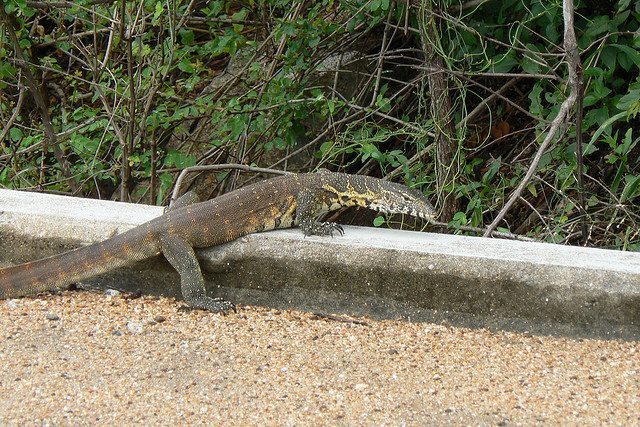There is a carnivorous monster in the state of Florida. This monster is the Nile monitor lizard. State wildlife staff is hunting for the lizards that can grow to be over five feet and are rumored to be consuming Florida house cats.
Some Florida wildlife officials are concerned that thousands of the large lizards are roaming free in the state and terrorizing the people of Palm Beach County and their pets, especially their cats. Since July of 2014, there have been 20 Nile monitor lizards captured by The Florida Fish and Wildlife Conservation Commission.
What Are Nile Monitor Lizards?
The Nile monitor lizards are an invasive species in Florida as they are native to Africa, not the sunshine state. The exotic pet market brought them to Florida, and the lizards seem to enjoy the climate. People purchase them when they are small and then find they cannot handle the growing lizard that can span five feet in length. Instead of dropping the lizards off at a sanctuary or calling animal control, they are released into the wild where they breed and increase in numbers. The lizards are spreading across southern Florida.
They survive by eating owls, reptiles, domestic cats, and small dogs. One Floridian claims that a five-foot long Nile Monitor Lizard claimed his Dachshund puppies. The feral cat community is also shrinking, according to the Sun Sentinel.
The Nile Monitor Lizard, being from Sub-Saharan Africa, has the genetic makeup to grow up to eight feet long although only five-foot long specimens have been spotted. Their usual menu in their native land is a steady menu of small prey, and so the folks in Cape Coral are blaming the lizards for their missing or devoured pets.
The Nile Monitor Lizard is the less familiar cousin of the well-known and loved Komodo dragon, and as such feasts on a regular diet of small mammals, owls, fish, reptiles, tortoises. The endangered and vulnerable native species like the Key Largo wood rat. Their growing presence in Florida has led to a massive campaign to eliminate them. Every month the state sends out four to six patrols with orders to shoot first and ask questions later. This patrol has increased from just once a month, showing that this is becoming a larger problem. To date, 20 of these lizards have been killed, and the goal is to kill them all before they can breed even more.
How Many Nile Monitor Lizards Are in Florida?
There is a belief that there are hundreds of them in Florida’s wild, especially along Palm Beach County’s canals and waterways. They are mostly seen along a 12-mile portion of those waterways that runs from the Loxahatchee National Wildlife Refuge to Southern Boulevard and Interstate 95.
Conservation biologists have labeled the Nile Monitor Lizard as one of the “worst invasive reptiles” in the United States. They have been characterized as hulking beasts and voracious predators of anything smaller than themselves. If they cannot be controlled by The Florida Fish and Wildlife Conservation Commission campaign, they could wipe out smaller native wildlife. They threaten feral and domestic cats, small dogs, and possibly other small animals.
Could the Nile Monitor Lizard Attack Humans?
The Nile Monitor Lizard is not likely to attack humans unless provoked. These lizards join so many other invasive species in Florida due to the exotic pet trade. Many of these species threaten the native wildlife and small domestic pets of southern Florida including the Burmese pythons, hydrilla plants, and poisonous lionfish.
What You Can Do?
In addition to their monthly patrols, The Florida Fish and Wildlife Conservation Commission is distributing fliers that ask for anyone who sees a Nile Monitor Lizard to photograph it and report it to authorities. The monitor skin tone runs from brown to dark olive to a light yellow. They have yellow markings on their backs. Getting actual pictures of them is necessary for the wildlife authorities because they look so much like any other lizard. Take note of the location as well.
If you are in Florida, you can report an invasive animal online at www.IveGot1.org.
The Nile monitor lizard is not only found in the Cape Coral area but also in the Homestead-Miami Speedway area where it is projected that another very large population of monitors lives. They have been seen in Broward County, and officials are not certain at this time if this is another breeding population or not.
It is hoped that the multiple monthly patrols that dispose of the lizards, will accomplish the goal of eradicating the species before one or more massive breeding populations takes root in any given area in Florida. Until then, it seems it is up to the owners of domestic cats to keep them indoors. Keep dogs leashed or in a fenced in yard. Pet owners beware.
Photo: Courtesy of Chris Eason via Flickr (CC by 2.0)










